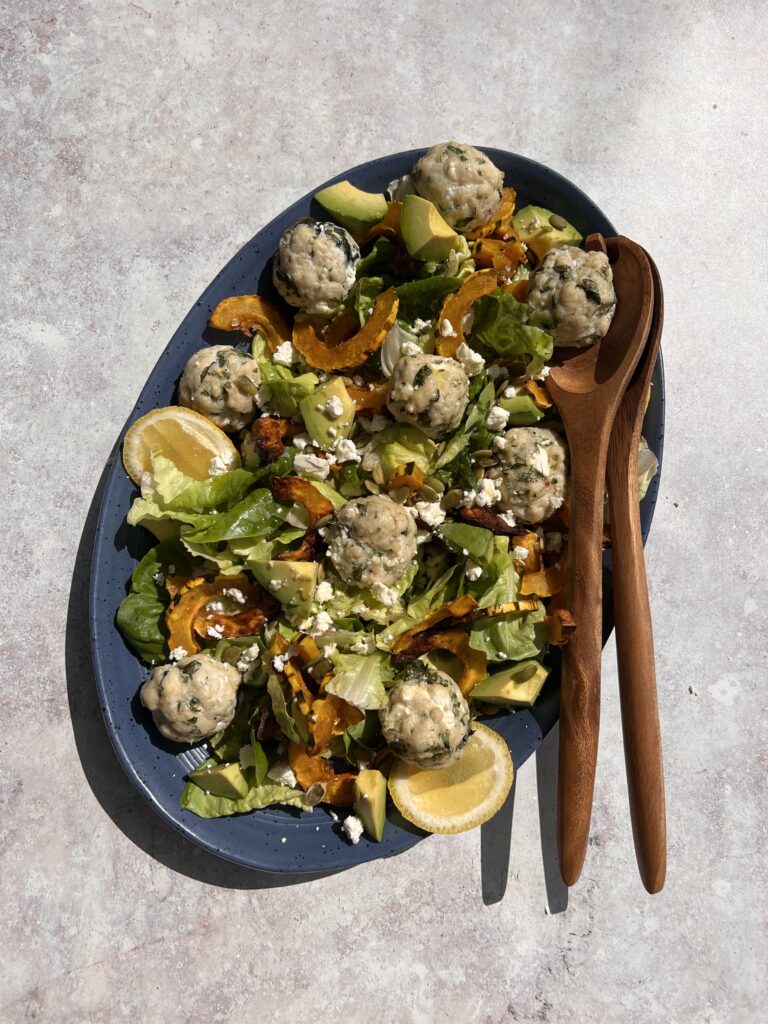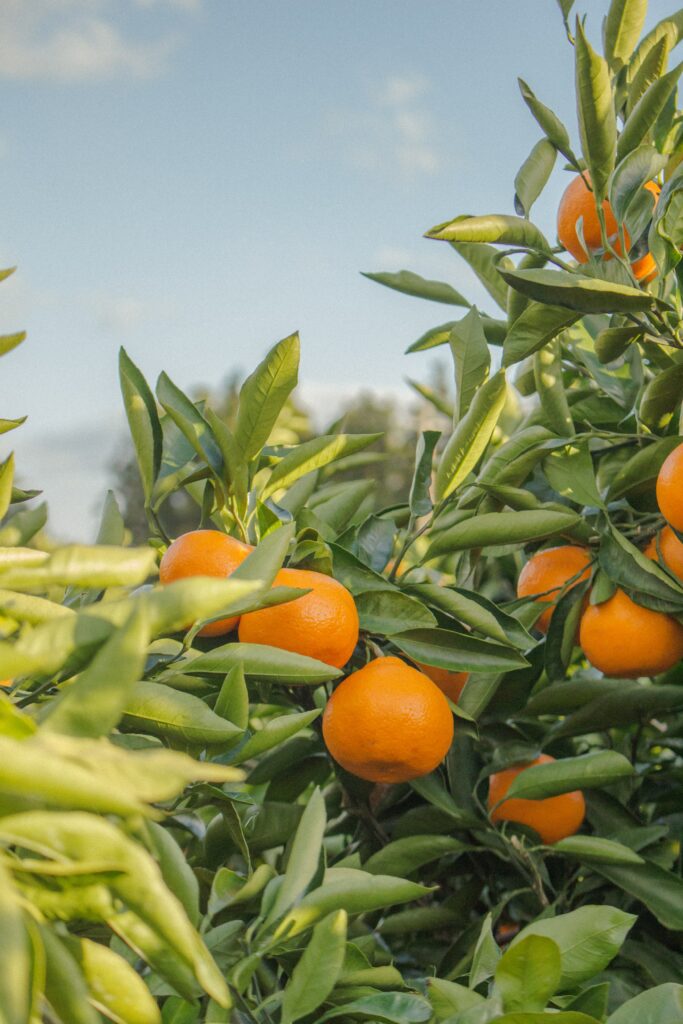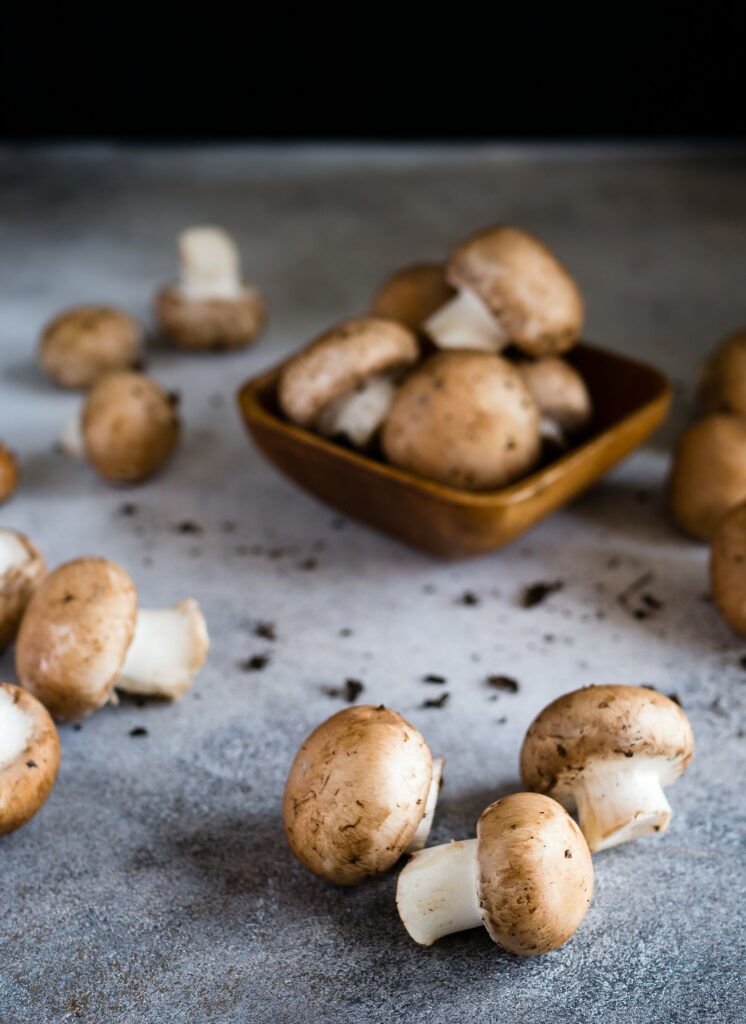And just like that, it’s the final produce guide of 2023! We’re wrapping up the year with vibrant colors and nourishing ingredients. Think: wild mushrooms, juicy kiwifruit, earthy beets, sweet clementines, and purple cauliflower. When it comes to produce, there’s no better time to eat the rainbow. Especially to support your winter immune system and counterbalance decadent holiday treats. Amidst tins of cookies and trays of casseroles, make space for this December 2023 produce guide. It’s filled with fiber-rich, blood sugar-friendly ingredients. Without further ado, let’s dive into produce in season—December edition.

prioritize your gut health
As we bid farewell to 2023, there’s no better time to hone in on your gut health. After all, it leads to better digestion, balanced hormones, improved sleep, and more. Because the bacteria in your gut influences the health of your entire body, a healthy microbiome is key. Read: you want a diverse microbiome. Generally speaking, a diverse gut is an optimal gut. The more species of bacteria you have, the more health rewards you reap. So, how to improve your gut health? In part, by letting this December 2023 produce guide fill your grocery basket.
EAT A DIVERSE ARRAY OF WHOLE FOODS
This includes produce rich in fiber and antioxidants. A diverse diet (ideally, with minimal sugar and industrial seed oils) can lead to a more diverse microbiome, which is beneficial for your health. When in doubt, focus on the produce section of the grocery store.
PRIORITIZE THE MEDITERRANEAN DIET
There are a variety of reasons to eat like the Mediterraneans do. But mainly because of its emphasis on vegetables, fruits, beans, and legumes. These are high-fiber, gut-friendly foods that promote the growth of beneficial bacteria. Eating a range of fresh, whole foods, mainly from plant sources, is shown to improve gut health.
CHOOSE FERMENTED FOODS
Fermented foods, like plain yogurt, kimchi, and tempeh can benefit the microbiome. They enhance its function and reduce the abundance of disease-causing bacteria in the intestines.
ADD IN PREBIOTICS
Many fruits, vegetables, and whole grains contain prebiotics, but they can also be found on their own. Resistant starch (like an unripe banana) can also be a prebiotic. If eating an unripe banana sounds unappetizing, you can also benefit from prebiotics by eating cooked and cooled potatoes and rice. The cooling process turns some of the digestible starches into resistant starches.
CONSUME PROBIOTICS
Beyond probiotic-rich foods, opt for a probiotic supplement. In essence, probiotics are often referred to as the “good”—or “helpful”—bacteria. They help keep your gut humming along. In addition to supporting digestive health, probiotics can also help with overall immune function.
LIMIT SUGAR
This is easier said than done in December, but we want to keep blood sugar balanced. After all, chronically elevated glucose levels can reduce beneficial bacteria. When it comes to baking holiday cookies and pies, consider swapping common sources of sugar for their lower-glycemic alternatives.

December meal plan
With seasonal eating in mind, below is a sample winter meal plan.
Breakfast:
- Protein-packed oats, topped with kiwi, walnuts, and cinnamon
- Latte: coffee, matcha, or black tea with frothed milk of choice
Lunch:
- Prosciutto, butternut squash, and goat cheese salad
- Warm ginger tea (prepare by boiling a nub of fresh ginger in 8 oz water), straining, and adding a squeeze of lemon and a drizzle of raw honey
Dinner:
For snacks and dessert, try Hu Chocolate dipped in almond butter, a healthy pumpkin muffin with a pat of ghee, or a mug of bone broth and a clementine.

December 2023 PRODUCE GUIDE
Like November, December is all about fall-to-winter fare. Blackberries make way for mandarine oranges, pears, and cranberries. In the spirit of winter’s most delicious produce, below are the ingredients to focus on in December.
Apples
If you haven’t already, it’s time to start stocking up! Apple season is here. I love crisp, chopped apples in salads with goat cheese, along with apple slices dipped in almond butter. Apples sautéed apples in coconut oil and cinnamon, are the best yogurt or oatmeal topping. When possible, opt for organic apples. Conventionally grown apples are highly sprayed with pesticides and then coated with wax. If you’re debating what to buy organic, apples are worth it.
broccoli
Despite seeing broccoli year-round in the grocery store, broccoli is a cold-weather crop and tastes best when harvested in the fall. December broccoli heads will be large and plentiful, compared to the smaller bunches during the warm months. If you are only familiar with steamed broccoli, you’ll be happy to know there are a plethora of creative broccoli recipes—from pasta dishes to curry to pancakes. And once roast broccoli with salt and nutritional yeast, you may never boil or steam it again.
brussels sprouts
Brussels sprouts are in season, and if you can, purchase them on the stalk as these will be the freshest. I love them caramelized with garlic and shaved into a salad, but you can also steam and roast them. Brussels sprouts are high in fiber, vitamins, minerals, and antioxidants, making them a nutritious addition to your autumn diet. And fun fact, cruciferous veggies are known as healing foods to support optimal health and hormones. They effectively metabolize excess estrogen, supporting those with hormonal imbalance.
CArrots
While they’re a year-round supermarket staple, carrots actually have two seasons. There’s a late-spring crop as well as a fall crop. Early season carrots are sown in the winter and very early spring and protected with plastic or fleece covers. They are harvested from June through to August. Green top carrots are sown in the open ground in spring and are harvested from August until the first frosts start to appear. Raw carrots are fantastic for balancing hormones (especially if you’re estrogen dominant).
cauliflower
Along with broccoli and Brussels sprouts, cauliflower is another cruciferous veggie with a variety of health benefits. When roasted, cauliflower takes on a whole new persona—creamy on the inside, a little crispy on the outside, and a sweet nuttiness that can’t be matched. In addition to starring in a number of side dishes, you can replace white flour with a cauliflower crust in your family’s pizza recipe, or swap out cauliflower rice for regular next time you plan a stir-fry.
Chestnuts
Nothing reminds most of us of the holiday season than freshly roasted chestnuts. Make sure to score them first before roasting (or they’ll explode). If using in recipes, jarred chestnuts work better than fresh. Look for both fresh and jarred chestnuts this month.
Cranberries
We’re in the thick of cranberry season. In the U.S., cranberries are only harvested in the fall and should be available at your local grocery store from September through January. You can eat them raw, pulse them into a relish, or blend cranberries into a super nutritious smoothie. They also freeze beautifully.
Kale
One of my favorite winter greens (once wilted or massaged), kale is extremely hardy. The most cold tolerant varieties can survive down to -10 degrees Fahrenheit! Kale, along with beets, carrots, and leeks, also taste better in the winter. Reason being, the the starch molecules in the plants convert to sugar molecules when the weather is cold.
Kiwis
Traditionally, most people slice kiwis in half in order to scoop out the fruit and leave the skin behind. While this helps get the meat of the fruit out, you’re leaving fiber behind! You can 100% eat the brown and fuzzy skin of a kiwi. While the texture may intimidate you at first, in reality, it is similar to the skin of a peach or pear. Kiwis are high in vitamin C, supporting heart health, digestive health, and immunity.
Kumquats
Kumquats look like tiny oranges, but unlike oranges, these small fruits are eaten whole—peel and all. The peel is full of nutrients and tastes sweet and aromatic. Although they can be eaten whole, wash and dry them thoroughly before consumption. Kumquat fruit has zero GI and low sugar content, which makes it a superfood for those with diabetes. This fruit hardly raises blood sugar levels!
Leeks
Leeks—like figs—can be categorized as summer and winter. The winter harvest begins in October and produces a larger, stronger flavored vegetable than the warmer month version. They can keep for up to two weeks in the fridge, and will also do well frozen. The main ingredient in leek and potato soup, this elongated green and white stalk is also delicious when sautéed with chicken, swiss chard, or spinach.
Madarine oranges
December is the month for mandarin oranges—satsumas, clementines, and tangerines. Halos and Cuties brands are super sweet seedless clementines. These are packed with vitamin C.
Parsnips
They look like a carrot’s very pale cousin, but parsnips are much sweeter and more versatile. Along with being soup vegetables, they’re also lovely when roasted, braised, pureed, and even crisped up as fries.
Pears
Like apples, it’s peak pear season, and there are a variety of pears to choose from. Ultimately, the recipe you’re making will determine which pear(s) you buy. For example, if you’re making a cheese plate, opt for winter pears—also called Danjour or Anjou pears. This variety works best with cheeses that won’t overpower their flavor. That said, there are endless ways to use pears. This salad is delicious, as is this pear crisp. If you’re looking for a ripe pear to eat immediately, find a browner or more yellow-colored pear with no green undertones. There should be no soft spots on the pears, and it should be fairly firm.
POMEGRANATES
Pomegranates are rich in antioxidants and flavonoids, both of which are known to lower inflammation in the body. In some studies, pomegranates show potential to be effective in preventing prostate, breast, lung, and colon cancers. Pomegranates are a delicious, nutritious fruit—but getting them open can seem tricky. Learn how to cut and de-seed a pomegranate without making a mess!
Wild Mushrooms
Depending on where you live, you may be able to find fresh porcini, chanterelles, and other wild mushrooms at your local grocer (or farmers market). Sauté them with ghee, olive oil, sea salt, and tarragon.
winter Squash
‘Tis the season for all types of winter squash: acorn, delicata, spaghetti, kabocha, butternut, and more. Here’s my helpful guide to squash—different varies, how to cook them, etc.




Leave a Reply